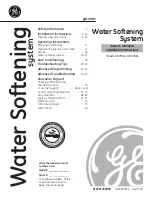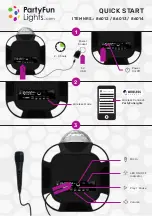
3.
Wear suitable clothing to reduce risk of burns to exposed skin.
3.1
Wear durable, flame-resistant clothing with closed, opaque weaves. This
reduces chance of ‘sun’ burn, contact burns, and accidental ignition of
clothing that could occur.
3.1.1
Do not wear wet or damp clothing.
3.2
Wear appropriate gloves, shoes, and outer protection as described to
prevent electrical shock.
4.
Protect others from arc rays that can burn unintentionally.
4.1
Provide suitable screening to reduce exposure of others to existing weld-
ing areas.
4.2
Provide proper eye protection.
4.3
Provide suitable clothing.
BALANCE EQUIPMENT
Minor personal injury
or damage to equipment
1.
Improperly balanced equipment can result in personal injury and/or damage to
equipment.
2.
Check and maintain equipment daily for safe operation.
3.
Read and understand the manufacturer’s instructions for this equipment and
other welding equipment. This includes your employer’s safety practices.
CHECK MSDS
For most
efficient operation
1.
Material Safety Data Sheets are designed to help you understand how to safely
work with chemicals and materials in your work area.
1.1
Follow data sheet instructions for proper ventilation or respiration.
1.2
Follow proper first aid treatment should accidents occur.
1.3
Keep proper fire extinguishing equipment as denoted on data sheet.
1.4
Do not exceed exposure limits.
1.5
Dispose of material properly.
2.
Read and understand data sheets regarding the hazards associated with the use
of chemicals and materials.
SAFETY REFERENCES
AWS Z49.1
(ANSI) “Safety in Welding and Cutting”
AWS C5.6
“Recommended Safe Practices for Gas-Metal Arc Welding”
AWS F4.1
“Recommended Safe Practices for the Preparation for Welding
and Cutting of Containers and Piping”
AWS C5.1
“Recommended Practices for Plasma Arc Welding”
AWS C5.3
“Recommended Practices for Air Carbon Arc Gouging and Cutting”
Available from the American Welding Society, P.O. Box
351040, Miami, Florida 33135
ANSI Z41
“Standard for Personal Protection - Protective Footwear”
ANSI Z49.1
“Safety in Welding and Cutting”
ANSI Z87.1
“Practice for Occupational and Educational Eye and Face Protection”
ANSI Z88 .2
“Standard Practice for Respiratory Protection”
Available from the American National Standards Institute,
11 W. 42nd St., New York, NY 10036
Code of Federal Regulations (OSHA)
Section 29, Parts 1900-1910.999 and 1910.1000-
Available from the U.S. Government Printing Office,
Washington, DC 20402
CSA W117.2
“Safety in Welding, Cutting, and Allied Processes”
Available from the Canadian Standards Association, 178
Rexdale Blvd., Rexdale, Ontario, Canada M9W 1R3
CGA Pub. P-1
“Safe Handling of Compressed Gas in Containers”
Available from the Compressed Gas Association, 1725
Jefferson Davis Highway, Arlington. VA 22202-4100
NFPA51B
“Fire Prevention in Cutting and Welding Processes”
NPFA70
“National Electrical Code”
Available from the National Fire Protection Association,
Batterymarch Park, Quincy, MA 02269
FUMES & GASES
Some probability of
death or serious injury
1.
Ill
ness or death can result from breathing fumes, gases, or oxygen enrichment or
depletion that welding may produce.
2.
Provide proper ventilation to avoid breathing fumes and gases produced by
welding. It may be necessary to supply fresh air to the welder with an air-supplied
respirator or other means when working in a confined space.
3.
The three major toxic gases associated with GMAW are ozone, nitrogen dioxide,
and carbon monoxide.
4.
Do not weld near degreasing or other cleaning operations involving
chlorinated hydrocarbons. Heat and arc rays can react with solvent vapors and
form phosgene, a highly toxic gas, along with other irritating products.
5.
Shielding gases can displace air. Use special care to insure that breathing air is
safe when welding in confined area. Upon entering a confined space, check the
breathing air to make sure it is safe. Check gas connections for leaks after installa-
tion and regularly thereafter.
6.
If welding causes dizziness, nausea, or respiratory irritation, ventilation is inad-
equate.
7.
Operate engine-powered equipment in open, well-ventilated areas or exhaust the
engine’s fumes outdoors. Never ventilate with oxygen.
8.
Read and understand the manufacturer’s instructions for this equipment and other
welding equipment. This includes the Material Safety Data Sheets (MSDS) and
your employer’s safety practices.
PINCH POINTS
Some probability of
death or serious injury
1.
Keep clothing, tools, hands, fingers, or any other part of your body away from
moving parts of the machine such as v-belts, gears, and fans.
2.
Never operate any equipment without safety guards.
HOT
Minor personal injury
or damage to equipment
1.
Hot metal such as electrode stubs and workpieces should never be handled.
1.1
Serious burns and injury can occur from accidental contact with hot mate-
rials.
1.2
Wear protective clothing to prevent burns to exposed skin.
1.2.1
Wear insulated gloves.
1.2.2
Wear clothing that resists heat penetration and ignition.
1.3
Assume that all metal pieces in the weld area are hot.
2.
If touching, always test any metal and discarded electrodes for heat. Do not as-
sume any material in the welding area is cool to touch.
3.
Mark welded work HOT or place small pieces in marked container.
1.
The welding arc produces a bright light emitting concentrated volumes of
ultraviolet and infrared rays. These rays are harmful to unprotected eyes or skin.
Protection shall be taken to inhibit exposure.
2.
Protect eyes from arc rays.
2.1
Do not observe the arc or its reflection without eye protection including
filtered lenses.
2.1.1
Filters with cover plates shall be worn to reduce exposure to rays.
2.1.2
Cracked or broken lenses should be replaced immediate ly, reduc-
ing risk of unfiltered light entry into eyes.
2.2
Protect face area from arc rays by using proper hooding and shields.
2.2.1
Hood shall be opaque.
2.2.2
Hood shall be replaced immediately, reducing risk of unfiltered
light entry, should cracks or holes occur.
Minor personal injury
or damage to equipment
ARC RAYS
CAN BURN






























